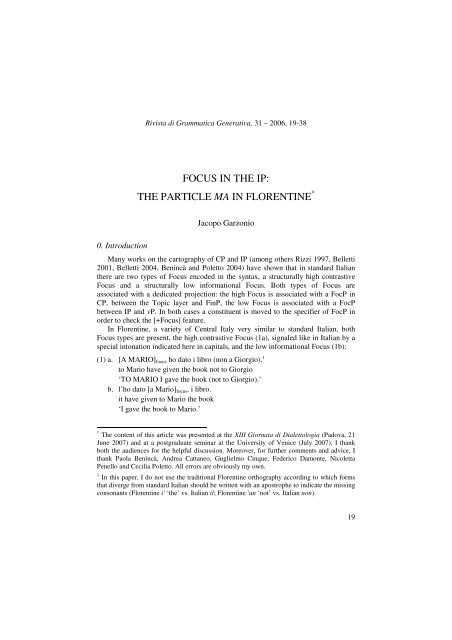Untitled - Lear
Untitled - Lear
Untitled - Lear
You also want an ePaper? Increase the reach of your titles
YUMPU automatically turns print PDFs into web optimized ePapers that Google loves.
0. Introduction<br />
Rivista di Grammatica Generativa, 31 – 2006, 19-38<br />
FOCUS IN THE IP:<br />
THE PARTICLE MA IN FLORENTINE *<br />
Jacopo Garzonio<br />
Many works on the cartography of CP and IP (among others Rizzi 1997, Belletti<br />
2001, Belletti 2004, Benincà and Poletto 2004) have shown that in standard Italian<br />
there are two types of Focus encoded in the syntax, a structurally high contrastive<br />
Focus and a structurally low informational Focus. Both types of Focus are<br />
associated with a dedicated projection: the high Focus is associated with a FocP in<br />
CP, between the Topic layer and FinP, the low Focus is associated with a FocP<br />
between IP and vP. In both cases a constituent is moved to the specifier of FocP in<br />
order to check the [+Focus] feature.<br />
In Florentine, a variety of Central Italy very similar to standard Italian, both<br />
Focus types are present, the high contrastive Focus (1a), signaled like in Italian by a<br />
special intonation indicated here in capitals, and the low informational Focus (1b):<br />
(1) a. [A MARIO]focus ho dato i libro (non a Giorgio). 1<br />
to Mario have given the book not to Giorgio<br />
‘TO MARIO I gave the book (not to Giorgio).’<br />
b. l’ho dato [a Mario]focus, i libro.<br />
it have given to Mario the book<br />
‘I gave the book to Mario.’<br />
* The content of this article was presented at the XIII Giornata di Dialettologia (Padova, 21<br />
June 2007) and at a postgraduate seminar at the University of Venice (July 2007). I thank<br />
both the audiences for the helpful discussion. Moreover, for further comments and advice, I<br />
thank Paola Benincà, Andrea Cattaneo, Guglielmo Cinque, Federico Damonte, Nicoletta<br />
Penello and Cecilia Poletto. All errors are obviously my own.<br />
1 In this paper, I do not use the traditional Florentine orthography according to which forms<br />
that diverge from standard Italian should be written with an apostrophe to indicate the missing<br />
consonants (Florentine i' ‘the’ vs. Italian il; Florentine 'un ‘not’ vs. Italian non).<br />
19
















